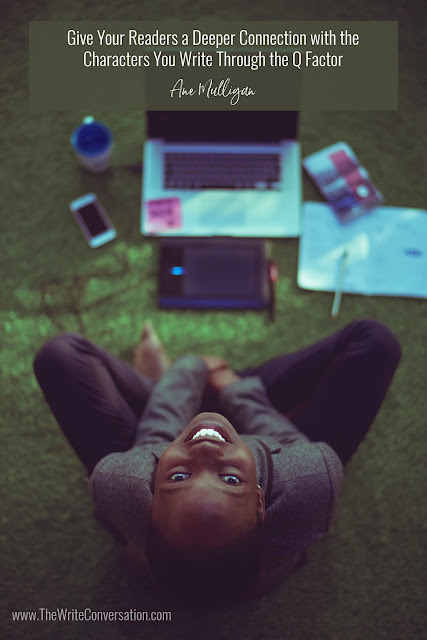by Ane Mulligan @AneMulligan
I learned about the Q Factor from James Scott Bell several years ago at the BRMCWC. He’s given me permission to share it.
So what is the Q Factor for Writers?
It’s a great tool that comes from Dr. Q, in the James Bond movies. He’s the one who gives Bond his gadgets, so during the crucial scene where Bond is dangling by his ankles over a school of piranha, he manages to get his thumb on a cufflink. That cufflink turns into a small, rotating saw, which he uses to cut through the restraints on his hands and legs. He then reaches into his jacket pocket and pulls out a fountain pen. The pen holds a compressed nitrogen charge and shoots a small grappling hook and line across the piranha pond, enabling Bond to swing to safety on the other side of the pool.
Now, if we had been watching the movie and come to this point, and Bond simply produced those items for the first time, we wouldn’t believe it. How very convenient and a load of codswallop. We’d walk out of the theater.
But because Dr. Q set it up, and because we saw these items before, we accept them when they’re used.
The Q factor in fiction
In fiction, the Protagonist should reach a point near the end when everything looks lost. In figurative terms, she is dangling over a pool of piranha. She needs courage for the final battle, to face the ultimate test.
This is where the Q Factor can help. It is something set up early in the story that will provide the necessary inspiration or instruction for the character when she needs it most.
In Chapel Springs Revival, my Q Factor was Claire’s late Great-aunt Lola. The first time her husband went to work without kissing her goodbye, she left, went to Hollywood and became a big star in silent films. Claire remembers that when her hubby leaves for work without kissing her goodbye. This sets up the story question: will Claire leave her husband?
Now we cut to the black moment, when Claire’s hubby walks out of the house in anger, after he learns something she did. At the appropriate time, Claire goes to the attic and reads Aunt Lola’s journals. In them, what she learns helps her make a decision.
Another way to look at it is this: so many stories are about overcoming fear. The fear manifests itself most when all the forces are marshaled against the Protagonist. Fear and common sense tell her to give up, run away. She knows she can't. So give her a Q Factor, an emotional element that comes in when she needs it.
How to Give Your Character a Q Factor
1. Decide what the element will be (item, mentor-sidekick, moral sentiment or emotion, negative character, etc.)
2. Write a scene early in the narrative that ties this element emotionally to the Protagonist.
3. Refer to the Q Factor subtly in the middle section, as a reminder.
4. Find a trigger point in your Protagonist’s black moment where the Q Factor can be reintroduced.
5. Show your Protagonist taking new action based on the Q Factor. If you've embedded the Q well enough up front, the readers will pick up what's happening without you having to explain it to them. Just let it happen naturally.
The Q Factor is just another tool to add to your technique box. I like collecting these and finding new ways to incorporate them.
Share a favorite writing tool from your technique box.
TWEETABLE
Give Your Readers a Deeper Connection with the Characters You Write Through the Q Factor, insight from author @AneMulligan on @EdieMelson (Click to Tweet)Ane Mulligan lives life from a director’s chair, both in theatre and at her desk, creating novels. Entranced with story by age three, at five she saw PETER PAN onstage and was struck with a fever from which she never recovered—stage fever. One day, her passions collided, and an award-winning, bestselling novelist immerged. She believes chocolate and coffee are two of the four major food groups and lives in Sugar Hill, GA, with her artist husband and a rascally Rottweiler. Find Ane on her website, Amazon Author page, Facebook, Instagram, Pinterest, The Write Conversation, and Blue Ridge Conference Blog.
Featured Image: Photo by Oluwakemi Solaja on Unsplash


Excellent information, Ane! As always. Thank you.
ReplyDeleteThanks, MaryAnn. It's a great tool.
DeleteI love James Scott Bell!
ReplyDeleteMe, too, Dalyn!
DeleteOutstanding!
ReplyDeleteThanks, DiAnn!
DeleteThis comment has been removed by the author.
Delete